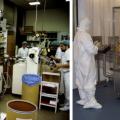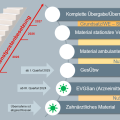Temporary bleeding control by intrathoracic transdiaphragmatic -Foley´s catheter application in torrential transdiaphragmatic bleeding
Directorate for Trauma and Burns, Chris Hani Baragwanath Academic Hospital, University of the Witwatersrand Medical School, Johannesburg, Republic of South Africa1 (Academic Head, Division of Trauma: Prof. Elias Degiannis), Department of Surgery, 4th Surgical Clinic, “Attikon” University Hospital, Athens, Greece2 (Director: Vassilios Smyrniotis), and the Department of Procto-Surgery, St. Marienhospital, Vechta, Germany3 (Medical Director: Dr. Olaf Hagemann).
D. Doll
Summary
This case reports presents a young male patient with thoracoabdominal trauma caused by a stab to the posterior chest and consecutive torrential transdiaphragmatic bleeding into the intercostal drain that necessitated thoracotomy. Blind insertion of a Foley´s catheter through the diaphragmatic defect controlled the exsanguinating bleeding from the abdominal activity that had caused the hemothorax. On laparotomy, it was found to occlude a defect in the anterior wall of the inferior (IVC) vena cava – this is why the patients survived..
Conclusion: The purpose of this case report is not to show that “luck favours the brave” but it is to support the use of Foley´s catheter balloon in penetrating trauma with torrential bleeding from liver tracts in preparation of definitive control of the injury to the liver parenchyma or its´ major vessels.
Keywords: Stab chest, penetrating, thoracoabdominal injury, balloon occlusion, IVC
Zusammenfassung:
Wir berichten über einen jungen männlichen Patienten mit einer penetrierenden thorako-abdominellen Verletzung durch einen Stich in den unteren rechten Rücken. Diese hatte zu einer transdiaphragmalen Massenblutung geführt, die sich durch die Thoraxdrainage entleerte und eine Thorakotomie erforderte. Die „blinde“ Einlage eines Foley-Katheters durch den Zwerchfelldefekt in den Stichkanal konnte das Ausbluten des Patienten über eine abdominelle Blutungsquelle, welche ursächlich für den Hämatothorax war, stoppen. Bei der anschließenden Laparotomie fand sich ein Defekt in der Vorderwand der Vena cava inferior, der lebensrettend durch den Ballon des Katheters verschlossen wurde.
Folgerungen: Dieser Bericht soll kein Beispiel für das „Glück des Tüchtigen“ sein, sondern ein Plädoyer für den lebensrettenden Einsatz des Ballonkatheters bei penetrierenden Verletzungen mit nicht zu stoppender Massenblutung in der Leberregion, um so die Zeit bis zur definitiven chirurgischen Versorgung zu überbrücken.
Schlüsselworte: Stichverletzung des Thorax, Penetration, thorakoabdominales Trauma, Ballonverschluss, Vena cava inferior.
Case report
A 27 year old male was brought to hospital with a stab wound at the posterolateral aspect of his right lower thoracic cage at the level of T7. His systolic blood pressure was 65 mm Hg, his pulse rate was 134/min and his respiratory rate was 22/min. There was dullness at the right side of the chest and an intercostal drain (ICD) was immediately inserted that drained 1700 ml of frank blood. The patient was rushed to theatre and a right anterior lateral thoracotomy was performed. At operation, a small laceration at the lower lobe of the right lung was found as well as a 2 cm laceration of the right diaphragm through which there was torrential bleeding originating from the abdomen.
Having made the assumption that the bleeding was originating from the liver parenchyma, it was felt that the insertion of a Foley´s catheter through the diaphragmatic defect into the liver would probably help to decrease the exsanguinating bleeding by exerting pressure in the bleeding liver parenchyma. The Foley´s catheter was cautiously inflated, and the bleeding into the thoracic cavity stopped. The thoracotomy incision was left open, and we proceeded to a laparotomy. On inspection of the right diaphragm, to the surprise of the treating surgeon, it was found that the Foley´s balloon was occluding a large defect at the anterior wall of the retrohepatic inferior vena cava (IVC) that was the source of bleeding (figure 1). This IVC defect was repaired with a continuous 3 - 0 Prolene suture. The diaphragm was also repaired and both laparotomy and thoracotomy incisions were closed. The patient was discharged in good general condition on day 8.
Discussion
The decision on which cavity to operate on first in the presence of thoracoabdominal injury can be taxing [1]. In most instances the peritoneal cavity takes priority over the pleural cavity bleeding [2, 3], and most penetrating chest injuries can be managed by the insertion of an intercostal drain [4]. In the case of our patient who arrived in hospital in great physiological derangement the clinical examination indicated the presence of fluid in the right pleural cavity and the insertion of an intercostal drain drained a large amount of blood (1700 ml). This was an indication for immediate thoracotomy. When the origin of the bleeding was identified as originating from the abdominal cavity, most probably from the liver parenchyma, this was attempted to be temporarily controlled [reduced] by the insertion of a
Foley ´s catheter and inflation of its´ balloon. This method of controlling bleeding in penetrating trauma has well been described particularly in trauma to the three zones of the neck as well as in other areas of the body where operative access is technically difficult to achieve [6]. The use of this technique reduces mortality as shown by WEPPNER et al. in 2013 [7]. Stabbing injuries of vessels in the supraclavicular region, the upper neck close to the skull base or to the flank where use of a tourniquet is impossible are indications for application of a Foley´s catheter [8]. In the emergency room (in case of an emergency thoracotomy) and in the operating room an Foley´s catheter can be used to achieve temporary haemostasis [9] so that the patient can be stabilized until the surgical procedures can start.
It could well be debated that suturing of the diaphragmatic defect without insertion of the Foley´s catheter could have the same result in controlling the hemorrhage from the liver parenchyma. This could well be the case if the injury was involving the bare area of the liver in which case the expanding hemorrhage could have tamponaded the bleeding by having its´ expansion restricted between the diaphragm and the ligaments of the liver [10]. As it was impossible to know the exact site of the bleeding it was decided to insert the Foley´s catheter.
The surgeon could have never guessed that the catheter would have “accidentally” been inserted and occlude the wall defect of the retrohepatic inferior vena cava that was the site of the injury.
It is impossible to state if the inflated balloon was causing partial or complete obstruction of the inferior vena cava. The fact that the patient did not have bowel edema, and there was no derangement of his renal function postoperatively, supports the possibility of the balloon was obstructing only partially the inferior vena cava. On the other hand it can be debated that even a complete obstruction of the IVC at this level could not have affected any organ function as the conversion from the thoracotomy to a laparotomy and the access at the injury site took place in less than 10 minutes.
Conclusions and take away message
The benefit of the “big yellow Foley´s catheter” is often underestimated in military medicine and emergency surgery.
The purpose of this case report is not to show that “luck favours the brave” but it is to support the use of Foley´s catheter balloon in penetrating trauma with torrential bleeding from liver tracts in preparation of definitive control of the injury to the liver parenchyma or its´ major vessels.
References
- Asensio JA, Arroyo H, Jr., Veloz W, et al.: Penetrating thoracoabdominal injuries: ongoing dilemma-which cavity and when? World J Surg 2002 May; 26(5): 539-543.
- Degiannis E, Zinn RJ: Pitfalls in penetrating thoracic trauma (lessons we learned the hard way...). Ulus Travma Acil Cerrahi Derg 2008 October; 14(4): 261-267.
- Loogna P, Bonanno F, Bowley DM, Doll D, et al.: Emergency thoracic surgery for penetrating, non-mediastinal trauma. ANZ J Surg 2007 March; 77(3): 142-145.
- Kong VY, Oosthuizen GV, Sartorius B, Keene C, Clarke DL: An audit of the complications of intercostal chest drain insertion in a high volume trauma service in South Africa. Ann R Coll Surg Engl 2014 November; 96(8): 609-613.
- Moore JB, Moore EE, Thompson JS. Abdominal injuries associated with penetrating trauma in the lower chest. Am J Surg 1980 December; 140(6): 724-730.
- Degiannis E, Bonanno F, Titius W, Smith M, Doll D: Treatment of penetrating injuries of neck, chest and extremities. Chirurg 2005; 76(10): 945-958.
- Weppner J: Improved mortality from penetrating neck and maxillofacial trauma using Foley catheter balloon tamponade in combat. J Trauma Acute Care Surg 2013; 75(2): 220-224.
- Doll D, Lenz S, Lieber A, et al.: What to do if incompressible bleeding from a stab wound occurs in EMS and ER? Temporary control with a Foley catheter. Unfallchirurg 2006; 109(10): 898-900.
- Attard G: The use of the Foley catheter in the emergency room treatment of penetrating cardiac injuries. Injury 1986; 17(1): 43-44.
- Degiannis E, Yilmaz TH, Doll D: Thoracoabdominal injury. In: Velmahos G, Degiannis E & Doll D (Eds): Penetrating Trauma. A Practical Guide on Operative Technique and Peri-Operative Management. Springer Berlin Heidelberg London New York 2012.
Disclosure: There is no conflict of interest.
Picture: Courtesy Dr. Asad Mushtaq
Author:
Lieutenant Colonel (Reserve) Priv.-Doz. Dr. Dietrich Doll
Department of Surgery, St. Marienhospital Vechta
Academic Teaching Hospital of the Hannover University
Marienstr. 6 - 8, D - 49377 Vechta, Germany
E-Mail: [email protected]
Datum: 29.08.2016
Wehrmedizinische Monatsschrift 2016/5










